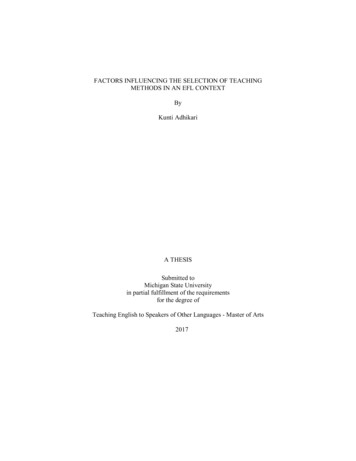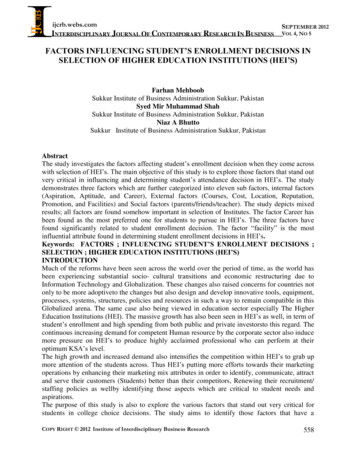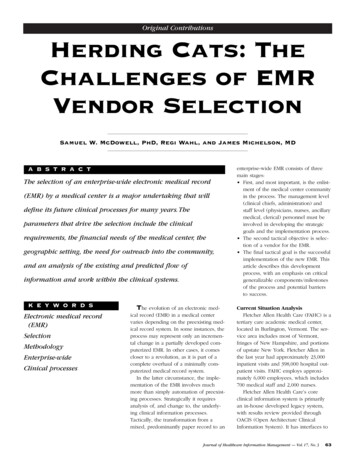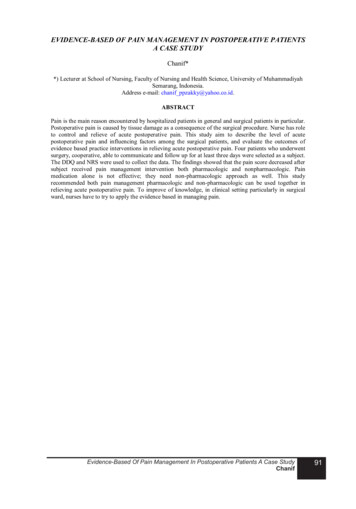
Transcription
FACTORS INFLUENCING THE SELECTION OF TEACHINGMETHODS IN AN EFL CONTEXTByKunti AdhikariA THESISSubmitted toMichigan State Universityin partial fulfillment of the requirementsfor the degree ofTeaching English to Speakers of Other Languages - Master of Arts2017
ABSTRACTFACTORS INFLUENCING THE SELECTION OF TEACHING METHODS IN AN EFL CONTEXTByKunti AdhikariThis study investigates the factors influencing the selection of English language teaching methodsin a Nepalese EFL context. The Secondary Education Curriculum (grades 8, 9, and 10) of Nepaldeveloped by Curriculum Development Centre, Ministry of Education, prescribes communicativelanguage teaching (CLT) in an English language classroom. However, in most of the cases, teachersexperience difficulties in implementing learner centered teaching techniques due to several factorsprevailing inside and outside the classrooms. Therefore, sometimes they practice methods other than CLTto teach English.This study surveyed those aspects, influencing the teachers’ selection of teaching methods in aNepalese EFL setting. It also explored the perceived difficulties of English language teachers in thecourse of implementing CLT along with the strategies that the teachers have been practicing to overcomethe existing problems in their English classrooms.The data were obtained online from the English language teachers in Nepal by employing aquestionnaire and a semi-structured Skype interview guideline as research tools. The informationcollected was reviewed and analyzed quantitatively as well as qualitatively. The findings of this researchwill help the policy makers and program developers in the Ministry of Education, Nepal to betterunderstand the existing school level English language teaching (ELT) situation.
ACKNOWLEDGEMENTSI would like to extend my sincere thanks to the English language teachers in Nepal whoparticipated in this research study and provided me with valuable data without which this study would nothave been possible. I would like to extend my sincere gratitude to my thesis supervisor and my professorDr. Paula Winke for her constant guidance and advice throughout my MA TESOL journey andthroughout this study. I am thankful to my academic advisor and my professor Dr. Charlene Polio, thesecond reader of my thesis, for her suggestions on the draft of this document. I acknowledge the directand indirect support that I received from my professor Dr. Debra Hardison throughout the MA TESOLprogram and firsthand information from her on research methodology.I am thankful to the College of Arts and Letters for providing me with the fund for this study. Iwill not miss this opportunity to thank my husband, Ram for his great support and for creating a favorablestudy environment throughout my MA TESOL program. My hearty thanks go to my son, Abhi for all hispatience during my study. I would like to remember my inspiring and encouraging family members andfriends for their direct and indirect support during my stay in the U.S.iii
TABLE OF CONTENTSLIST OF TABLES . viLIST OF FIGURES . viiINTRODUCTION . 1CHAPTER 1: LITERATURE REVIEW . 2Communicative Language Teaching (CLT) . 2Barriers to CLT . 3Large Classroom . 6Washback . 9Teacher Cognition. 11Selecting Appropriate Methodology . 14Factors Influencing the Selection of Teaching Methods in an EFL Context . 15Research Context: ELT Situation in Nepal . 18Introduction. 18ELT Curriculum. 19Student Assessment . 20Teacher Preparation . 20CLT in the Context of Nepal . 21Research Questions . 22CHAPTER 2: METHODOLOGY . 23Method . 23Participants. 23Tools . 23Procedure . 25CHAPTER 3: DATA ANALYSIS AND INTERPRETATION . 26Factors Influencing the Selection of Teaching Methods in Nepalese EFL Context . 26Problems Perceived by the Teachers in Implementing Communicative Language Teaching . 32Strategies Practiced to Overcome the Problems . 36CHAPTER 4: SUMMARY OF RESULTS, DISCUSSION, RECOMMENDATIONS, ANDCONCLUSION . 38Summary of Results . 38Discussion . 39Recommendations . 40Conclusion . 42APPENDICES . 44Appendix A: Questionnaire . 45Appendix B: Semi-structured Online Interview Guidelines . 50iv
REFERENCES . 51v
LIST OF TABLESTable 1: Background Information of the Participants of the Study .24Table 2: Problems Experienced by the Teachers in a Large Size Classroom .33vi
LIST OF FIGURESFigure 1: Factors Influencing the Selection of Teaching Methods in Nepalese EFLContext .27Figure 2: Problems Perceived by English Language Teachers in ImplementingCommunicative Language Teaching .32vii
INTRODUCTIONThe school level (Grade 1-12) curriculum of Nepal introduced English as a compulsory foreignlanguage in 2001, and it has been compulsory since then. The curriculum prescribes communicativelanguage teaching (CLT) as a method to teach English. A syllabus has been designed with an intent todevelop communicative competence among the learners. The textbooks and teachers’ guide are prepared,and the teachers are trained so as to achieve the goals of CLT. Despite the government initiatives most ofthe teachers are still unable to practice CLT in a real sense as they are influenced by several contextualfactors (Adhikari, 2010; Karki, 2014, Khatri, 2010). The curriculum may not always be implemented inthe way the curriculum designers intended (Orafi & Borg, 2009).Although teachers in several Asian-Pacific countries (Chang, 2011) and East-Asian countries(Littlewood, 2007) have tried to employ CLT in a foreign language classroom in recent years, researchershave reported that a gap exists between ELT policy documents and the real practice of teaching andlearning of English. This policy-teaching gap has been identified by the authors of several studies (Cook,2010, Hu, 2005; Roy, 2016; Razmjoo & Riazi, 2006; Zhang & Liu, 2014).Teaching English in an EFL context, especially in inadequately equipped and under-resourcedclassrooms where the learners have minimal exposure to English, is a demanding task. Teachers arerequired to consider the classroom reality and are guided by contextual factors around them while tryingto implement CLT (Roy, 2016). Internal and external aspects such as classroom size, availability ofauthentic resources, technology, the national assessment system, teacher training and education, andteacher’s beliefs have a strong influence on how the teacher performs inside a classroom (Jafari,Sokrapour, & Gutterman, 2015; Mustafa, 2001). Unfortunately, most influencing factors are beyond theteachers’ control, so the teachers find it really challenging to overcome the problems created by theexternal factors. In this study, I investigate the factors exerting a significant impact on instructionalpractices in compulsory English classrooms in Nepal.1
CHAPTER 1: LITERATURE REVIEWCommunicative Language Teaching (CLT)Communicative language teaching, a language teaching method that has attracted the attention ofteachers and educators all over the world, has become a buzzword frequently mentioned in the field ofsecond and foreign language learning (Brown, 2007; Liu, 2015). Scholars around the world have beeninvolved in discussing, reviewing, and improving CLT since its conception, while many textbooks havebeen written and syllabi designed based on this method (Ju, 2013). As noted by Mitchell and Myles,(2004, p. 3) CLT is a dominant language teaching method in many parts of the world becausecommunicative competence is the goal of foreign language learning.Hymes (1971) employed the term communicative competence in reaction to the notion ofcompetence that Chomsky proposed (Liu, 2015; Savignon, 2007). Hymes (1971) wrote that,- “being ableto communicate requires more than linguistic competence; It requires communicative competence –knowing when and how to say what to whom” (as cited in Larsen-Freeman & Anderson, 2011, p.115).The communicative method considers fluency as an important dimension of communication, and learningas a process of creative construction involving trial and errors. CLT comprises the effectivecharacteristics of other pre-existing methods (Brown, 2007). According to Lee and Van Patten (2003,p.10), one of the significant changes introduced by CLT is the role of an instructor from a “drill leader” to“an opportunity provider” for communication.CLT provides students with more opportunities for language practice and ensures their activeparticipation in language learning, involving them in activities such as pair work, group work, role-plays,information gap tasks, and language games. Constant learner and teacher motivation is likely to determinethe success of CLT and will compensate for several limitations of this approach to language teaching(Canale & Swain, 1980).Larsen-Freeman and Anderson (2011) provide the following characteristics of CLT:1. Authentic language should be introduced whenever possible.2
2. The target language is vehicle for classroom communication.3. Games are important because they have certain features in common with real communicativeevents- there is a purpose to the exchange.4. Having students work in small groups maximizes the amount of communicative practice theyreceive.5. Errors are tolerated and seen as a natural outcome of the development of communicativeskills.6. Students’ accuracy as well as fluency is evaluated.7. The teacher acts as a facilitator in setting up communicative activities and as an advisorduring the activities.8. Students work on all four skills from the beginning.Barriers to CLTOnce the education authorities adopt CLT for the foreign language curriculum, they become keento know what teachers understand about CLT and how well the teachers have incorporated this approachinto their foreign language teaching already (Razmjoo & Riazi, 2006). Communicative competence hasbeen the goal of foreign language learning, and CLT has been considered as a dominant languageteaching method, in many parts of the world as noted by Mitchell and Myles, (2004, p.3). However,CLT’s relevance in the foreign language teaching context, especially in inadequately equipped, crowdedclassrooms driven by grammar- based tests, has been questioned by many researchers. Although the pastfew decades witnessed the development and popularity of CLT in the world, and even though severalcountries have widely adopted a communicative curriculum, the implementation aspect of CLT in somecountries cannot be considered satisfactory (Eroz & Azamat, 2016; Ju, 2013). As a result, CLT has beenaccused of being a method developed by native speakers and one not able to suit foreign languageteaching contexts.3
Most foreign and second language teachers are aware of CLT and of their personal roles insupporting a communicative classroom. But on the other hand, several studies (Abe, 2013; Chang, 2011;Cook, 2010; Liu, 2015 ; Orafi & Borg, 2009; Roy, 2016; Zhang & Liu, 2013) have shown that foreignlanguage teachers are often unable to implement CLT satisfactorily for various reasons. Most of thesestudies were conducted in a Chinese EFL context. These studies were related to the implementation ofCLT and focused on the challenges encountered by teachers in the foreign language classrooms and theperception of the teachers as well as the students towards communicative language teaching.Butler (2011) identified several challenges encountered in Asian contexts while teachers try toimplement CLT. Butler categorized those challenges as (a) conceptual constraints (e.g., conflicts withlocal values and misconceptions regarding teaching learning) (b) classroom-level constraints (e.g., variousstudent and teacher-related factors, classroom management practices, number of students, and resourceavailability) and (c) societal- institutional level constraints (e.g., curricula and examination systems).According to her, in large classes of often unmotivated learners, there is an avoidance of English. Shesummarized that in an EFL setting, CLT’s incompatibility with public assessment demands, and itsconflict with educational values and traditions, act as powerful barriers to CLT in East Asian educationsystems.Ellis (1996) pointed out a few reasons for which CLT is often not very successful in EFL settings,while it is successfully implemented in ESL settings. According to him, ESL is integrative, in the sensethat it is designed to help language learners function in the target-language speaking community withlittle or no curricular demands or pressure of examinations. On the contrary, EFL is a part of a rigorousschool curriculum and, therefore, is influenced by several contextual factors such as school management,national curricula, assessment requirements, teachers’ language proficiency, and the availability ofteaching resources. The unsuccessful implementation of CLT can be most often attributed to these factorsin those contexts. Ellis also examined the role of the teaching-learning culture, particular pedagogicalpractices, and teacher-student relationships in the implementation of the communicative approach to4
language teaching in the Eastern and Western contexts. As he summarized, CLT may not be suitable in acontext, unless it is culturally familiar and accepted.Liu (2015) presented four possible reasons behind the failure of CLT in China: 1. Studentsmisconceive CLT. They think that CLT does not guarantee sufficient grammar knowledge and that is incontrast with their goal of learning English, that is, to pass standardized grammar-based examinations. 2.The communicative activities performed inside the classroom have little resemblance with the situationthey encounter outside the classroom. 3. Students are unable to maintain the balance betweencommunicative competence and linguistic competence 4. There is a lack of authentic materials availableto Chinese students in an EFL situation, and those materials are needed for CLT tasks and activities.Similarly, Hu (2002) identified sociocultural factors as the most influential barriers to the adoption ofCLT in the Chinese classroom. Those factors included a Chinese culture of teaching and learninggrammar and vocabulary, and a traditional perception about the roles and responsibilities of teachers andstudents, which resembles a more Socratic method of learning (which is when the teacher holds theknowledge, students receive the knowledge, and only teachers ask individual question in class). Thesefactors are in conflict with CLT in several respects.Nishino and Watanabe (2008) discussed the inhibiting role of contextual factors in theimplementation of communicative approaches in the Japanese classroom. According to them, lessexposure to the English language, the Japanese tradition of teacher-centered instruction, and Englishsections of high school or university entrance exams focusing on reading comprehension and a largenumber of (30 to 40) students in public secondary schools may not be the optimal conditions forcommunicative approaches. Some classroom, school, and society related factors, such as long entrenchednational exam systems, large-size classrooms, lack of authentic resources, and schoolmanagement/environment can be barriers to implementing CLT effectively in an EFL context (Eroz &Azamat, 2016).Despite all these challenges observed in many EFL setting, ELT practitioners are still striving tosuccessfully implement CLT in the hopes that ELT situation will improve in their respective countries5
(Li, 1998). As put forward by Ju (2013), challenges such as cultural conflicts and teacher training in theapplication of CLT in certain countries are continually discussed and CLT will not perform satisfactorilyin a language classroom unless it is combined with the characteristics seen in such countries. Thesecharacteristics, according to Ju, are things like large-sized teaching environments (that is classroom with60 or more students), educational backgrounds that do not include training in CLT, teaching culture inwhich more Socratic methods are the norm, and the test systems that are set at the national level andinclude the learning of language as object.The large classroom and negative washback are often perceived as major barriers to CLT in anEnglish classroom.Large ClassroomThere is no common understanding of how many students form a large classroom. According toUr (2005), the idea of large is relative and the concept of large class differs from one context to another.Ur further wrote that in some private language schools a group of 20 students may be considered large, inother settings a classroom with 40 to 45 students may be taken as a large class, whereas in some places aclass beyond 100 students may be considered to be a large classroom. The practitioners from differentpedagogical contexts define a large classroom in distinctive ways. Therefore, even within the samecountry, teachers’ perception of large class may differ based on the educational context and the level(Shamim, Negash, Chuku, & Demewoz, 2007). As exemplified by Shamim et al., a large class in theWestern contexts such as the United Kingdom or in the United States may be considered small by bothteachers and students in most teaching learning contexts in Africa, and thus a large class can vary from 24in the United States elementary school to up to 150 in an African classroom.A class can be considered large when the teacher finds it challenging to address the needs of theindividual student due to their number present in the classroom (Charleston, 1976). As stated by Benbow,Mizrachi, Olive & Said-Moshiro, (2007), a classroom can be called a large classroom if the studentteacher ratio exceeds 40 to1 and in such classrooms, conditions are common, particularly in the6
developing countries, where the student number in the class reaches upto100 or beyond that. Teachersaround the globe are facing several challenges while attempting to teach in overcrowded classes.According to Sharndama (2013), a large class is one that has more students than the recommended classsize, more students than learning materials and physical structures, prevents the teacher from working asexpected, and hampers students’ learning.The teacher’s performance and the students’ learning is severely affected in extremelyoverpopulated classrooms (Sharndama, 2013). The teacher has to spend valuable class time in controllingthe noise and student disruptions rather than focusing on teaching learning activities in the large classes.In such crowded classes, the individual student is buried (Abioye, 2010) in the sense that the teacher triesto interact with the students from diverse sociocultural background and learning abilities using the sameinstructional technique because it is difficult for the teacher to provide for the individual learning needsand aspirations of each student, and all at the same time. Although the students are highly motivated tolearn a language, inadequate learning materials, and over-crowded classes may contribute to creating anunfavorable learning environment.Throughout the world, and especially in the developing countries, English language teachers havebeen dealing with the large classes (Watson, 2006). The situation is similar in the classrooms of Nepal.The class of 40 to 50 students seems common in the government-aided schools in Nepal (Adhikari, 2010).Large classes do not exist accidentally in the Nepalese and in similar other contexts. As Sharndama(2013) noted, financial constraints, lack of space, materials, and qualified teachers compel thegovernment and school administrators to run large classes where the teachers have no training in how touse methods other than the lecture method, with little emphasis on collaboration, exploring, and sharingof ideas. Although large classes are disliked, such classes certainly exist in many EFL settings andeducators cannot get rid of this problem easily (Nan, 2014).Khati (2010) pointed out that large multilevel classes is one of the major challenges to ELT inNepal where the majority of classrooms consist of mixed level students with different needs and learningstyles. This type of heterogeneity is likely to enrich classroom interaction on one-hand and challenge the7
teachers’ resourcefulness on the other. Dealing with a large class is not an easy task for a teacher. Ives(2000) presented a list of challenges that the teachers experience in such class.1. Management of the paperwork: handing out, collecting, and recording tests and otherassignments, make-up work2. Management of distractions: talking, late arrivals, early departures3. Perceived anonymity of the students: difficulty of learning names, of taking attendance, of gettingstudents to come to class, of getting students to participate in class, of getting students to doassignments in a timely manner4. Lack of flexibility in class activities: difficulty in varying activities, in doing group work, inenhancing critical thinking and writing skill5. Diverse background and preparation of the students.Similarly, Ur (2005) described that it is difficult for teachers to handle disciplinary problems, correctwritten work, keep students motivated, ensure effective learning, find suitable materials, track individualprogress, and ensure participation. These are the major challenges for teachers in a large class. In a studyabout Thai teachers’ perception about large classes, Jimakorn & Singhasiri (2006) found that teaching thelarge classes was perceived as a challenging job by teachers as they experienced difficulty in severalaspects such as maintaining a relationship with their students, monitoring students’ activities andprogress, and giving feedback and assessments. The teachers find it challenging to be familiar with thestudents and to address the mixed ability students (Nikam, 2016; Ramjibhai, 2012).Practitioners have suggested some strategies to cope with the above-mentioned problems that ateacher may encounter in a large classroom. Khati (2010) recommended creating a collaborative workingatmosphere, providing a variety of works, and making all students involved in various activitiesappropriate for different levels as some of the alternatives that the teachers can try out in a largeheterogeneous class. Likewise, Harmer (1998) suggested the teachers use student leaders as one of thestrategies to manage an overcrowded classroom. Although the job of teaching a large language class is8
demanding, pedagogical planning, preparation, proper classroom management and handling, andmonitoring of students’ behavior can help (Nikam, 2016). While large classrooms seem to be anunavoidable feature of the developing countries, teaching and learning in such contexts can still beimproved by building the capacity of the teachers and school leaders to cope with this environment(Benbow et al., 2007).WashbackStudies emphasizing the uses, impact, and consequences of tests in educational, social, politicaland economic contexts is common (Shohamy, 2001). Several studies carried out in the area of languagetesting (Khaniya 2005, Luxia, 2005; ; Qi, 2005; Smith, 1991; Wall, 2000; Wall & Alderson, 1993; Winke,2011;) have discussed the impact of examinations on teaching, learning, and broader social context. Theinfluence that the tests exert on teaching and learning is referred to as washback. Following Alderson &Wall (1993), the term “washback” that refers to “influence” of a test on teaching and learning, iscommonly used in language teaching and testing literature. Washback as described, functions as thepowerful determiner of what happens in the classroom, and the teachers and learners do things they wouldnot necessarily do because of the test.Khaniya (2005, p. 56) viewed washback as an “inherent attribute of examination” that caninfluence the teaching and learning methods. He further wrote that the concept of washback whichoriginally had negative connotations, later emerged as “washback validity” which is considered to be oneof the most important criteria for a good examination. As noted by Xie & Andrews (2013), among thestudies carried out on washback, many of them stressed the detrimental impacts of the standardizedlanguage tests on teaching and learning. She noted an excessive practice of testing that restrains theclassroom goal of improving language ability.When important educational and professional decisions such as admission, graduation,employment, or promotion are made based on test results, such tests are considered high-stakes tests(Muñoz & Álvarez, 2010 ). The impact of a high-stakes test is so influential that the test result is9
considered a determiner of the test taker’s life chances (Crooks, 1998). The results of high-stakes testssuch as public examinations, large-scale standardized tests, or the external examinations reach far beyondthe classroom and are used for policy purposes: assessing educational equity; providing evidence onschool and effectiveness; allocating compensatory funds to school districts; evaluating effectiveness;accrediting school districts; classifying students for remediation and certifying successful completion ofhigh school (Airasian & Madaus , 1983).Test results are the tools that exert serious influence not only on the individuals but also on theprograms because important decisions about the education system and the program are made based on thetest results. These decisions have either negative or positive impact on the administrators, teachers, andstudents (Shohamy, Donitsa-Schmidt & Ferman,1996). Due to this fact, these tests most often determinethe teachers’ preferences and the content covered in the classroom. The research evidence suggests thatteachers select the content areas to be discussed in the classroom and the teaching learning activitiesbased on the test tasks (Khaniya, 1990; Smith, 1991).Because the reputation of the teachers and the schools can be strengthened or weakened with thepublication of test results, there may be negative consequences such as test anxiety in the classroom(Wall, 2000). Following Abioye (2010), although only the students take tests, the teacher is also beingtested by such tests in the s
This study investigates the factors influencing the selection of English language teaching methods in a Nepalese EFL context. The Secondary Education Curriculum (grades 8, 9, and 10) of Nepal developed by Curriculum Development Centre, Ministry of Education, prescribes communicative language teaching










